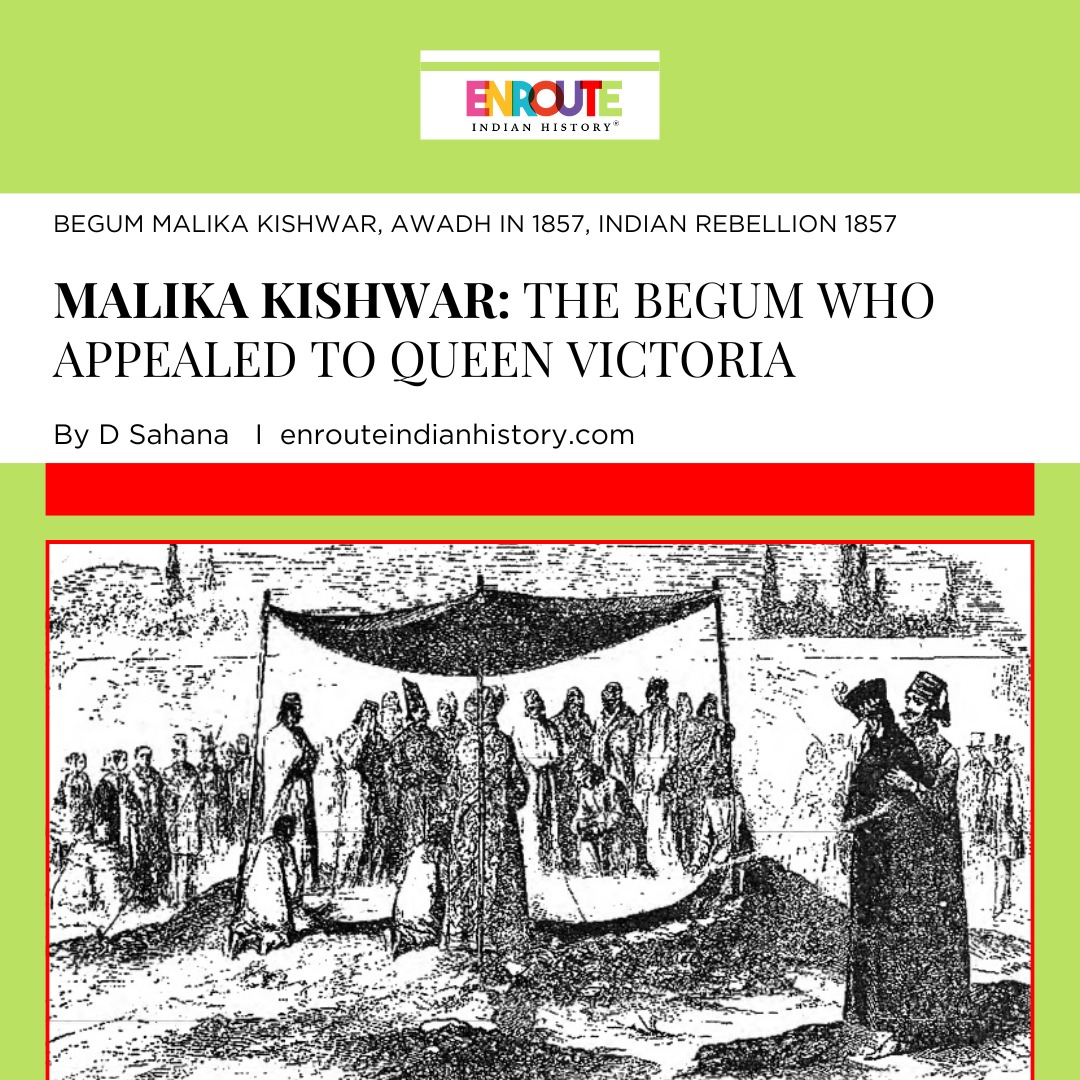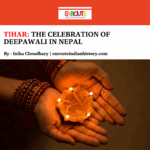
This is the story of how Queen Mother of Awadh(Oudh), Begum Malika Kishwar, ventured from her homeland to travel to England to meet Queen Victoria amidst the rising tensions caused by the East India Company in her native state. Despite spending most of her life in the zenana, she, her grandchildren, her other son, and numerous attendants set out to meet Queen Victoria at the onset of the revolt. She was a brave woman who defied all odds of what a traditional female Muslim elite ruler should be like and wanted to protect her homeland in ways she understood best. Even though her entire journey to England had been nothing short of turbulent, leading to her sad demise in France, she is still one of the most essential yet forgotten Indian women during the revolt of 1857.

The grave of Malika Kishwar at the Père Lachaise cemetery in Paris (Source:https://lifestyle.livemint.com/news/talking-point/malika-kishwar-a-forgotten-indian-queen-in-paris-111645963102481.html)
Malika Kishwar, the Queen Mother’s full name was Malika Kishwar Bahadur Fakr-ul-Zamani Nawab Taj Ara Begum Jenab Aliya Begum. She was the widow of King Amjad Ali Shah, the mother of the then Awadh ruler, Wajid Ali Shah. It was in February 1856 when Wajid Ali Shah, the last ruler of Awadh, was deposed under the pretext of the Doctrine of Lapse. He and his family were exiled to Bengal. These events resulted from the East India Company’s expansionist policies, which by 1858 led to the creation of North-Western Provinces and Oudh. To make his appeal, Wajid Ali Shah decided to go to London for a formal meeting with Queen Victoria. Begum Malika Kishwar, who had hardly seen the world beyond the palace walls(zenana), decided to accompany her son. However, his declining health led the Begum to embark without him. Soon, the royal party left Calcutta on the SS Bengal in June and reached Alexandria by June. Steamships run by the Peninsula and Oriental Company travelled regularly between Alexandria and Southampton, and the queen mother’s party reached Southampton on the SS Indus on 21 August 1856. Begum Malika Kishwar and one hundred ten of her attendants, including the Queen Mother’s medical officer, were the people who accompanied the Begum and her family. The entire party went straight to Mr. White’s Royal York Hotel in Southampton, which had been taken over for ten days at £ 100.

Royal York Hotel, Southampton, the image on their business card. This is the hotel where they stayed for the first ten days (source: http://sotonopedia.wikidot.com/page-browse:royal-york-hotel)
One of the many misfortunes to the royal family soon started occurring right after their journey to the seas. Firstly, there was an immense loss of money, £50,000 worth of jewels in the Red Sea, which were earlier meant as gifts for Queen Victoria. Soon after reaching England, the English press was not kind to them. Xenophobia and snobbery were the feelings faced by the people. The Queen Mother and her troop were looked at with disdain yet curiosity. They faced difficulties due to stark cultural differences; one such incident was when the station master refused to close the station to the general public when the Begum and her people boarded at Southhampton. As a woman in purdah, her eunuchs came to her rescue and made a human corridor, holding up calico sheets behind them, which helped the Begum pass.
It was not just the English newspapers reporting her Queen Mother’s arrival; even the newspapers back home in Awadh mentioned Begum Malika Kishwar and her activities in England. Faruqui Anjum Taban writes that events concerning the royal family naturally place prominence in Urdu newspapers. The visit of the Queen Mother, Malika Kishwar, to London is described in great detail in the Tilism (newspaper), which is also mentioned in the Sadiq-ul-Akhbar(newspaper). Both these papers also refer to parliament debates concerning the British Annexation. It also informs the readers that the Queen of Awadh had filed, at the office of the Court of Directors, a representation for the return of loans taken by the Company from the state of Awadh.

Map of Awadh (Source: WikiCommons)
MEETING QUEEN VICTORIA
Queen Victoria gave Begum Malika Kishwar an audience in July 1857 in a special court. By then, the Mutiny was well underway, and the story of the massacre of Englishmen in Kanpur had made headlines in the London newspapers.
Rosie Llewellyn-Jones mentions two accounts that mention Begum Malika Kishwar’s meeting with Queen Victoria, one of which was Queen Victoria’s journal. She writes “After luncheon received the Queen of Oude. There was much trouble in arranging that no man should look at her; she was placed in the “Closet” (next to the White Drawing room), where my ladies remained with her & her son and grandson. We entered behind her with our seven children, V. Smith and Sir G. Clark (who acted as interpreters). She threw back her veil and kissed my hand, which the grandson did. She was much weighed down by her heavy dress, her crown and jewels, being very small. She has fine eyes, painted, as is customary. The grandson also wore a crown, and both princes had long, loose robes, like dressing gowns. A few words were exchanged when the Queen and I were seated. Albert, with the two eldest boys and Gentlemen, stood behind her. She gave me a letter and a handsome ornament of pearls and precious stones, to which an ornament with sweet-smelling perfume was appended. I was inquisitive. We then retired but missed the exciting sight of her departure in the state.” This account shows us the profound cultural differences between the queens and highlights the curiosity and aura enwrapped around Begum Malika Kishwar.
The second account was by the historian Kamal-ud’din Haider, who Rosie Llewellyn-Jones writes could have been from one of the Awadh people who were present. He writes, ‘It had been agreed that apart from the two male attendants of Queen Victoria [and her husband and sons], no other men would be in the audience. Several female attendants escorted Jenab Alia(begum Malika Kishwar) from her carriage and taken into the small room to await Victoria’s arrival. The Queen came in wearing a simple ‘circular dress (a crinoline) and, after ‘respectful salutations’ from both sides, accepted a nazr of gold mohurs from the Indian Queen’. He also mentions that Queen Victoria enquired about Begum Malika Kishwar’s residence and, in the end, promised a fuller meeting in a week or so. However, this meeting never took place. The earlier meeting was mostly restricted to pleasantries.
THE MUTINY AND THE BEGUM
The situation back home was not going well, and the British public soon learnt about the large-scale Indian rebellion that had taken place in 1857. The royal party, however, remained in Marylebone. The situation had worsened because, by the time Queen Malika Kishwar wanted to head home via Mecca, Awadh State had ceased to exist. Hence, to return home, she and her family would have to request a British passport, which would mean accepting British power and being a British subject. However, there were several reasons why Queen Malika was denied a passport. Prem Poddar writes that “the denial of passports to the Queen of Oudh can be read as a reactive demarcation of Englishness against the contested claims of a supranational imperial ideology and as the belated reclamation of the geography of home against the supranational drive of empire”. Towards the end of the year, the Jenab Aliya(Begum Malika Kishwar) sought and received permission from the Court of Directors to leave England and proceed to Mecca on the journey home. She and her party soon set out to Paris from Harley House(her temporary residence) in January 1859 on the first stage of their return to India. The party settled into a hotel in the rue Laffitte, and it was here that Jenab Aliya passed away at age fifty-three. Soon, French officials informed the British Government of her death and their intention to honour the foreign queen. Arrangements were made for a royal funeral, which happened after four days. On 27th January, her body was borne in a hearse drawn by six horses to the newly opened Muslim portion of Pere Lachaise Cemetery, Paris, France.
Soon, her grandchildren and son also passed away and now rest near her in Pere Lachaise Cemetery.

Funeral of Queen Malika Kishwar in France (Source: Images of Lucknow-Roshan Taqui(ed.), page 72)

Funeral of Queen Malika Kishwar at sundown (Source: Images of Lucknow-Roshan Taqui(ed.), page 70)

Conveying the coffin to the Hearse (Source: Images of Lucknow-Roshan Taqui(ed.), page 70)
References:
Llewellyn-Jones, Rosie. “The Queen Mother’s Visit to England.” Images of Lucknow, New Royal Book Co., 2005, pp. 59-74. Accessed 26 May 2024.
Vijan, Simran. “Malika Kishwar: The Queen Who Ventured Beyond The Zenana | #IndianWomenInHistory.” Feminism in India, 27 January 2020, https://feminisminindia.com/2020/01/27/malika-kishwar-queen-ventured-beyond-zenana/. Accessed 26 May 2024.
Poddar, Prem. “The uses of the Passport: The Chess Players and Narratives of British Nationhood.” Journal of Postcolonial Writing, vol. 46, no. 5, 2010, pp. 517-528, https://doi.org/10.1080/17449855.2010.517057. Accessed 24 May 2024.
Taban, Faruqui Anjum. “The Coming of the Revolt in Awadh: The Evidence of Urdu Newspapers.” Social Scientist, vol. 26, no. 1/4, 1998, pp. 16–24. JSTOR, https://doi.org/10.2307/3517578. Accessed 26 May 2024.



















